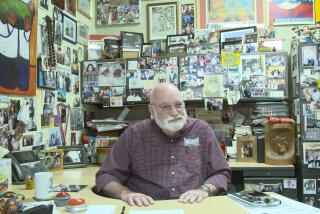Truth Is, We Want It All
For all the thunder about cleaning up “the mess in Sacramento,” the California recall campaign has been fairly uncluttered by substantive issues. All the candidates seem to agree that things aren’t working in state government. Many have promised to convene bodies of experts to figure out, after the election, how to fix whatever’s broken.
“Trust me, and my blue-ribbon commission to be named later,” seems to be a common theme on the campaign trail.
An exception to this opacity is what has come to be called “the car tax,” the tripling of vehicle license fees that was a byproduct of the struggle to balance the state budget.
State Sen. Tom McClintock has built his campaign around it, tacking “Stop the Car Tax” posters to seemingly every other telephone pole in rural California.
Arnold Schwarzenegger, speaking in Fresno last week, acted apoplectic as he deplored the hardships the car tax will bring to the poor -- and also to a certain action movie star with a taste for pricey Humvees.
Even Gov. Gray Davis has addressed the issue, offering it as a reason why, should he keep his job, he will seek to reorganize how the state manages its financial affairs.
As it turns out, the story of the car tax -- or the vehicle license fee, to call it by its actual but less poster-friendly name -- would not be a bad jumping-off point for any blue-ribbon commission out to explore “ the mess in Sacramento.” If nothing else, it illustrates just how complicated the machinery of government has become in California, where the only thing more unpopular than a raised tax is a cut program.
The history begins in 1935. At the time, automobile fees were treated as property taxes, the province of local governments. They set the rates, collected the money and spent it on the sort of ground-level amenities taxpayers tend to expect -- the cop on the beat, the firehouse around the corner, the public library, the neighborhood park.
Since property tax rates varied from county to county, inventive California motorists quickly learned to shop around, buying -- and registering -- automobiles where the rates were lowest. Advocates of good government found this messy and offered a better way: Let the state set, by formula, a uniform rate, collect the money and then return it in fair portions to the counties and cities.
And so it went for decades. Then, in 1978, came Proposition 13 -- the property tax revolt -- and a chaotic reorganizing of California government, with local governments becoming more and more dependent on state government. It was a time of shell games, of rabbits pulled from hats.
“And,” as Sacramento journalist Peter Schrag has noted, “the more efforts were exerted to make the system manageable, the more unmanageable and incomprehensive it became, thus setting off an accelerating cycle of reforms -- in the Legislature and increasingly by the initiative route -- which made the process even more unmanageable.”
One such reform was Proposition 47, a constitutional amendment put before voters in 1986. Sacramento had begun in budget crunches to dip into the automobile license revenues, and so advocates of the local governments thought it wise to stop future raids by setting in constitutional stone the long-standing arrangement with the state. The title of the initiative was banal: “Allocation of Vehicle License Fee Taxes to Counties and Cities.” It passed, 3,487,604 to 775,437.
Jump now to the late 1990s. Gov. Pete Wilson, looking to his legacy, decided he liked the sound of Champion Tax-Cutter. The tax he chose to cut? Yes, the vehicle license fee -- never mind that it wasn’t, technically, the state’s money to begin with.
Counties and cities were told not to worry. There would be, by statute, something called “backfill.” They would receive the same amount of money as generated through the vehicle license formula, only it would come from the (then) flush state general fund. And there would be a “trigger” -- if the state didn’t have the dough to pay the locals their due, vehicle license fees could be brought back to their previous levels.
And what fun it was for a while. Department of Motor Vehicles notices set the arithmetic in large type, demonstrating just how much each car registrant would have paid before Gov. Wilson’s reduction. In his first year in office, Davis grabbed some tax-cutting glory himself, sending the savings to car owners by check -- so they’d know whom to thank.
Sadly, the good times did not last. As the economy tanked, so did the amount of state tax revenues. And this year, with a $38-billion hole in the state budget, with the Legislature in stalemate, Davis pulled the vehicle license fee trigger and restored the old rate.
It might have been seen as keeping a promise to cities and counties, of doing what was needed, however painful, to maintain the cop on the beat, the firehouse around the corner, the public library and the neighborhood park. Instead, it has become the Davis “car tax.”
Red meat for the proponents of recall, and one more monument to the instinctive reluctance of Californians to pay for the government they seem to want.
Peter H. King’s twice-weekly column will run through the recall election.
More to Read
Start your day right
Sign up for Essential California for news, features and recommendations from the L.A. Times and beyond in your inbox six days a week.
You may occasionally receive promotional content from the Los Angeles Times.







